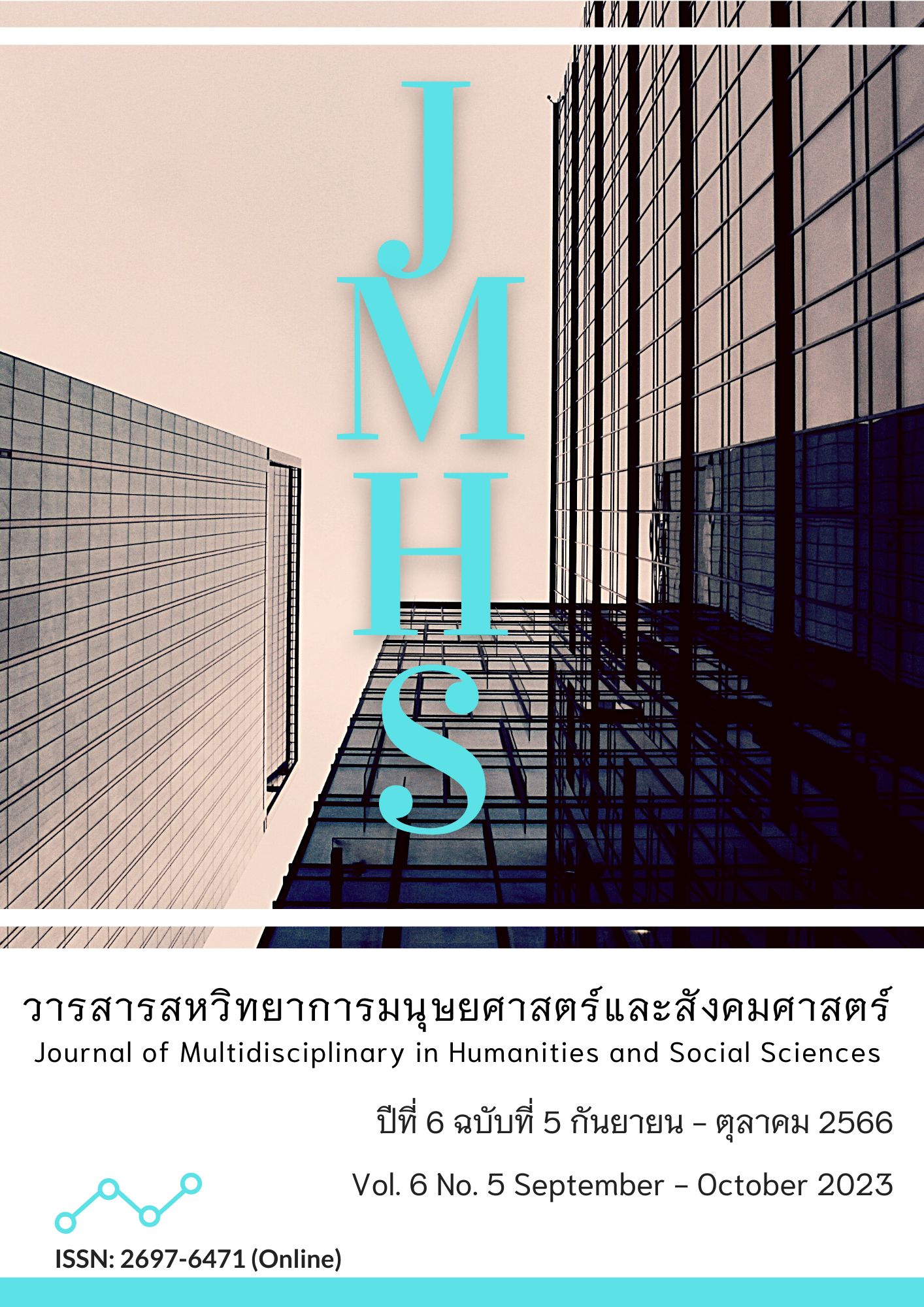Causal Factors Influencing Purchase Intention for Amulet from Jaoyingtarot Shop via Tiktok Application in Bangkok and Its Vicinity
Main Article Content
Abstract
The article aimed to 1) develop and validate a causal relationship model of purchase intention for amulet from Jaoyingtarot Shop via the TikTok application in Bangkok and its vicinity; and 2) study causal factors influencing purchase intention for amulet from Jaoyingtarot Shop via the TikTok application in Bangkok and its vicinity. This study was quantitative research. The sample consisted of people who have bought amulets from Jaoyingtarot Shop on the TikTok application and live in Bangkok and its vicinity (280 people) by convenience sampling. The tools used in the research were online questionnaires. The statistics used in data analysis were frequency, percentage, confirmatory factor analysis, and structural equation model.
The results of this research were the development of the causal relationship models, which consisted of four components: 1) social media influencer, 2) image, 3) self-concept, and 4) purchase intention. The model was consistent with the empirical data to a great extent. The statistic showed CMIN/df = 1.40, df = 137, GFI = 0.94, AGFI = 0.90, SRMR = 0.03, and RMSEA = 0.04. The final predictive coefficient was 0.90, indicating that the variables in the model can explain the variance of the purchase intention at Jaoyingtarot Shop by 90 percent. It was found that self-concept had the most direct influence on purchase intention. Entrepreneurs who sell sacred objects should consider product design that is in line with the personalities, tastes, and beliefs of consumers in order to create future purchase intentions.
Article Details

This work is licensed under a Creative Commons Attribution-NonCommercial-NoDerivatives 4.0 International License.
Views and opinions appearing in the Journal it is the responsibility of the author of the article, and does not constitute the view and responsibility of the editorial team.
References
กมลวรรณ อยู่วัฒนะ และ ณธสร เอื้อการณ์. (2565). การกำหนดนิติสัมพันธ์ในการโฆษณาสินค้าและบริการผ่านผู้ทรงอิทธิพลทางสื่อสังคมออนไลน์. วารสารนวัตกรรมและการจัดการ, 7(1), 30-40. สืบค้นจาก https://so03.tci-thaijo.org/index.php/journalcim/article/view/253871
ธีรศักดิ์ จินดาบถ, สุนันทา เหมทานนท์ และ พิไลวรรณ ประพฤติ. (2561). การรับรู้คุณค่าและความตั้งใจซื้อผลิตภัณฑ์ยางของผู้บริโภคชาวไทย. วารสารบริหารธุรกิจศรีนครินทรวิโรฒ, 9(2), 106-116. สืบค้นจาก https://ejournals.swu.ac.th/index.php/MBASBJ/article/download/10679/8862/31655
เมทยา ปรียานนท์ และ พัชนี เชยจรรยา. (2565). แบบจำลองปัจจัยความสำเร็จที่มีผลต่อความตั้งใจซื้อของผู้บริโภคในสื่อโฆษณาประเภทวิดีโอผ่านผู้มีอิทธิพลบนสังคมออนไลน์. วารสารนิเทศศาสตร์, 40(2), 127-142. สืบค้นจาก https://so02.tci-thaijo.org/index.php/jcomm/article/view/251180
ลลิตา พ่วงมหา. (2563). การใช้กลยุทธ์การตลาดออนไลน์เชิงอิทธิพลเพื่อสื่อสารแบรนด์ในยุคดิจิทัลอย่างมีประสิทธิภาพ. วารสารนิเทศศาสตร์, 38(3), 17-127. สืบค้นจาก https://so02.tci-thaijo.org/index.php/jcomm/article/download/240841/166169/861498
อานุมาต มะหมัด และ พีรภาว์ ทวีสุข. (2561). ภาพลักษณ์ตราสินค้าที่อิทธิพลต่อกระบวนการตัดสินใจซื้อผลิตภัณฑ์อาหารแปรรูปประเภทไส้กรอกในร้านสะดวกซื้อ A ในกรุงเทพมหานคร. วารสารสุทธิปริทัศน์, 32(103), 131–145. สืบค้นจาก https://so05.tci-thaijo.org/index.php/DPUSuthiparithatJournal/article/view/243599
Hair, J. F., Black, W. C., Babin, B. J., & Anderson, R. E. (2010). Multivariate Data Analysis. (7th ed.). Upper Saddle River, NJ: Prentice Hall.
Hair, J. F., Hult, G. T. M., Ringle, C. M., & Sarstedt, M. (2014). A Primer on Partial Least Squares Structural Equation Modeling (PLS-SEM). California, CA: Sage.
Hermanda, A. Sumarwan, U. & Tinaprilla, D. N. (2019). The Effect of Social Media Influencer on Brand Image, Self-Concept, and Purchase Intention, Journal of Consumer Sciences, 4(2), 76-89. Retrieved from https://journal.ipb.ac.id/index.php/jcs/article/view/26525/17503
Hoelter, J. W. (1983). The Effects of Role Evaluation and Commitment on Identity Salience. Social Psychology Quarterly, 46(2), 140–147. https://doi.org/10.2307/3033850
Hu, L.T., & Bentler, P. M. (1999). Cutoff Criteria for Fit Indexes in Covariance Structure Analysis: Conventional Criteria Versus New Alternatives. Structural Equation Modeling, 6(1), 1–55. https://doi.org/10.1080/10705519909540118
Joreskog, K. G., & Sorbom, D. (1984). Advances in Factor Analysis and Structural Equation Models. Lanham: Rowman & Littlefield.
Kline, R. B. (2011). Principles and Practices of Structural Equation Modeling. (3rd ed.). New York: The Guilford.
Sangwan, J., & Boonthawan, W. (2018). Effect of Integrated Marketing Communication and Brand Value Perception Toward Purchase Intention of Local Coffee Brand as The Perspective of Customers in Amphur Muang Lampang, Lampang Province. International Journal of Management and Applied Science, 4(1), 53-56.
Schreiber, J. B., Stage, F. K., King, J., Nora, A., & Barlow, E. A. (2006). Reporting Structural Equation Modeling and Confirmatory Factor Analysis Results: A Review. The Journal of Educational Research, 99(6), 323–337. https://doi.org/10.3200/JOER.99.6.323-338
Schumacker, R. E., & Lomax, R. G. (2004). A Beginner's Guide to Structural Equation Modeling. (2nd ed.). New Jersey: Lawrence Erlbaum Associates.
Shi, P., Lu, X., Zhou, Y., Sun, C., Wang, L., & Geng, B. (2021). Online Star vs. Celebrity Endorsements: The Role of Self-Concept and Advertising Appeal in Influencing Purchase Intention. Frontiers in Psychology Original Research, 12(1), 1-15. Retrieved from
https://www.frontiersin.org/articles/10.3389/fpsyg.2021.736883/full
Thompson, B. (2004). Exploratory and Confirmatory Factor Analysis: Understanding Concepts and Applications. Washington, D.C.: American Psychological Association.
Ullman, M. T. (2001). The Declarative/Procedural Model of Lexicon and Grammar. Journal of Psycholinguistic Research, 30(1), 37–69. https://doi.org/10.1023/A:1005204207369
Wadhwaa, B., & Chaihanchanchai, P. (2021). The Role of Online Influencer’s Characteristics in Attitude towards the Brand and Purchase Intention: A Case Study of L’Oréal. Communication and Media in Asia Pacific (CMAP), 4(2), 22-28. Retrieved from https://so01.tci-thaijo.org/index.php/CMAP/article/view/250257
Wu, J., & Wu, Y. (2023). From Participation to Consumption: The Role of Self-Concept in Creating Shared Values Among Sport Consumers. Psychology Research and Behavior Management, 16(1),1037-1050.


